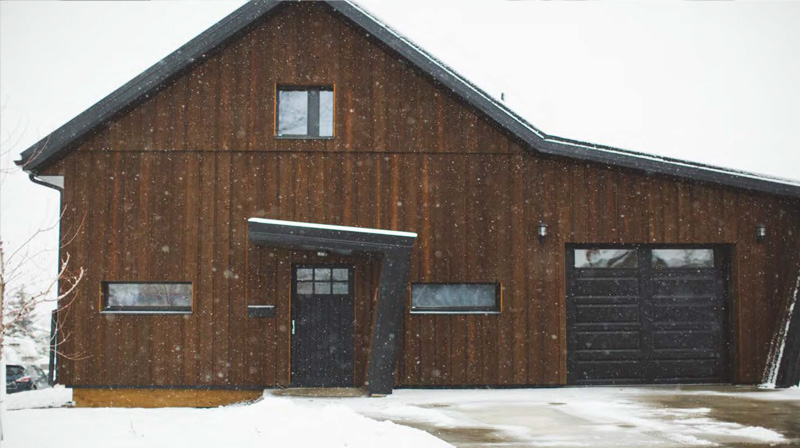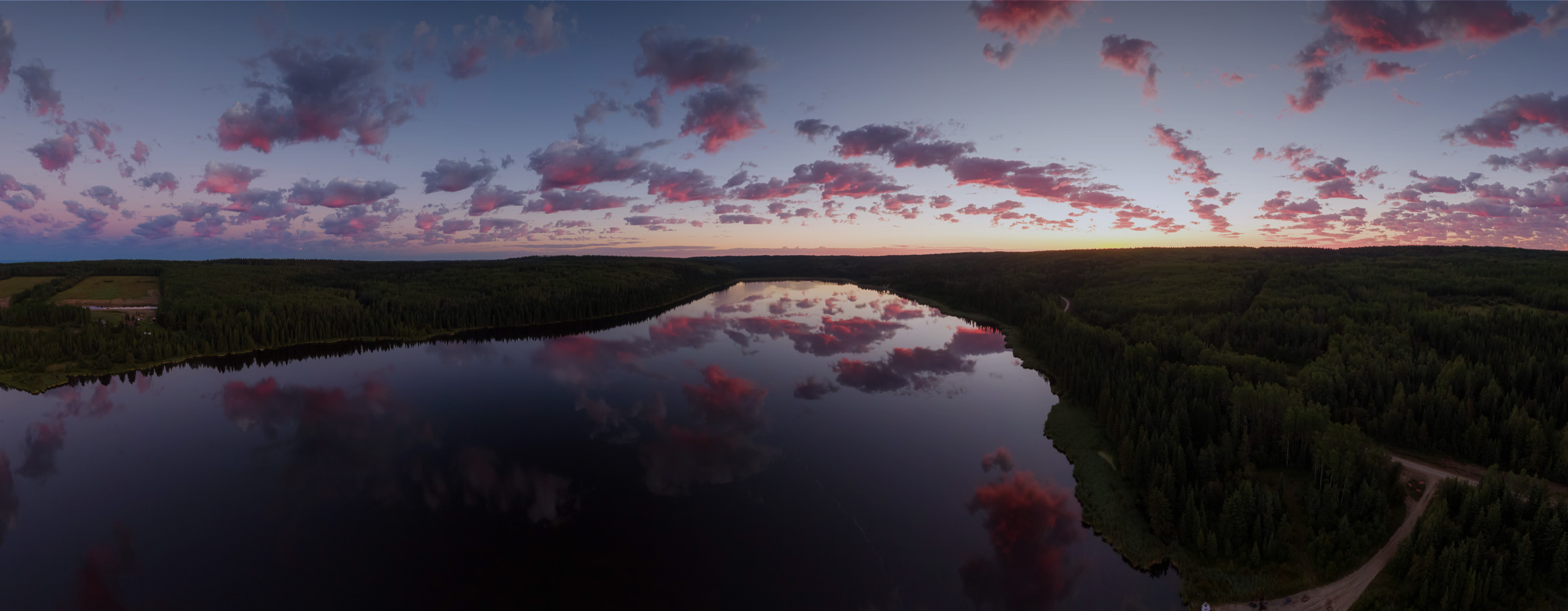Aggressively Passive

The ultimate success of sustainable design will require both a top down and bottom up approach. It will depend on transforming the cultural attitudes among building owners, and disseminating information among professionals to push the envelope of best practice standards. At the same time, public education will raise the awareness and expectations of building occupants and users, and encourage market transformation. Describe how the project addresses these concerns.
The project was used to teach the local building community about Passive House construction and low-energy building design. The house is a living classroom with public open houses, brochures, signs, workshops and website information.
The Mayor and City Manager presented at the 2015 North American Passive House Network Conference.
Building Life Cycle Considerations
The environmental impact of buildings begins with material extraction, and continues through fabrication, transportation, construction and operation, before ending with disassembly and disposal. Life Cycle Assessment influences material selection as well as the choice of building systems. Describe how life cycle issues were incorporated into the design approach including: designing for the anticipated service life of the building, the measures that have been taken to ensure flexibility in use, adaptability to other functions and demountability and recyclability of building components.
Performance Ratings:
- Certification as a Passive House plus (PH+) was achieved through PHIUS
- Energuide Rating of 91 • Certifiable as LEED Platinum (application in progress)
- Net-zero Energy Ready
- Airtightness level of 0.33 Air Changes per Hour @ 50pa
- 90% reduction in Green House Gas emissions compared to typical code built house.
Cellulose and mineral wool insulation and wood framing are easily reused in the future.
This single family home was designed as universally accessible to meet the needs of future residents with disabilities but the design also left much of the space as flexible in use. The building can also easily be adapted to business use and could be used by the City for workspace.
Materials and Resources
Describe how the selection of materials for the building address concerns for occupant health and comfort, durability, and building performance. Indicate how the materials chosen had lower environmental impacts and provided transparency, such as through health or environmental product declarations. Indicate any life cycle analysis conducted, the percentage of recycled materials used in the building, and the percentage of waste materials recycled during construction.
Some Green Building features include prefab panelized construction with cellulose insulation, photovoltaic energy production, triple pane wood windows, high efficiency heat recovery ventilation and more.
The comfort in the home has been addressed in previous questions with reference to the windows, doors and ventilation systems in the home.
The heating/cooling cost for the year is estimated to be $200-$400, which amounts to annual savings of approximately $1000-$1800 compared to an average house in this climate.
The house is 100% electric. Emissions are 0.05 tonnes of GHGs per year — over a 99% reduction in tonnes of GHGs relative to a typical single-family detached dwelling. Airtightness level of 0.33 Air Changes per Hour @ 50pa was achieved.
During construction all materials that were able to be recycled were recycled including cardboard and plastics
Energy Present and Future
Describe how the building’s mechanical, electrical and related control systems are integrated into passive design strategies including orientation, thermal mass and building cross section. Explain how these systems contribute to energy conservation, reduced pollution, improved building performance and comfort. What is the projected annual energy consumption for the building in MJ/m2? Indicate what percentage of the energy consumed is from renewable sources site installations, district heating systems, waste heat captured from adjacent buildings, or green power certificates], and how the building could respond to a future shortage of fossil fuels.
Energy efficient features include; an ultra-insulated building envelope reducing heating and cooling demand by 90%, a heat recovery ventilator with 90% heat recovery efficiency, a 99% reduction in greenhouse gas emissions (GHG’s), extreme air tightness, net-zero energy readiness, metal roofing, a solar electric array, high efficiency tilt/turn opening windows, and energy monitoring equipment.
A combination photopholtaic energy (estimated at 3,500 kWh/Area: 19m2 per year) and hydro-electric power is used. Air-source heat pumps with backup electric baseboards will emit 0.05 tonnes of GHGs per year — over a 99% reduction in tonnes of GHGs relative to a typical single-family detached dwelling.
The 9KW photovoltaic system is anticipated to cover up to 50% of the electric energy consumed over the year.
Water Conservation
Describe how building and site strategies conserve and manage water supplies, including measures to capitalize on renewable sources such as rainwater, and reusable sources such as building grey water. Indicate the strategies and technologies used for water conservation, and the projected potable water consumption per m2/occupant/annum for the building from municipal or other centralized off-site supply. What percentage improvement does this represent over the water consumption of the reference building?
The passive house utilizes low water flow products whenever possible: showerheads, toilets, faucets, dishwasher and washing machine.
The grass planted in the yard requires less water than other varieties. Much of the landscaping will be done this spring and the plantings are all a hardy variety and will have mulch around the roots to hold water.
Wellness
Describe how the design of the project addresses our understanding of how buildings can support both the physical and psychological health of their occupants. This may include material choices, introduction of biophilic elements, provision of social spaces, support of physical activity through design etc.
A passive home is essentially an affordable luxury home: affordable due to low monthly utility costs and luxury because of clean air and comfortable even temperatures.
Air: The mechanical system consists of a direct-ducted, filtered, ventilation system with heat recovery ventilator (HRV). Because a passive house is very close to air tight, the only air that does come into the home passes through the mechanical system which filters the air.
Temperature: The PHPP software permits detailed calculations of summer cooling loads. Our house is designed with appropriate summer shading on south-facing glazing and use spectrally selective glass to reduce summer overheating. The solar panels generate enough power to run an air conditioner without purchasing additional electricity.
Accessibility: The house was built to be universally accessible and complies with relevant portions of the Safer Home Standard.
Light and Air
Describe the day lighting and fresh air ventilation strategies, and how the building design and operation maximizes the effectiveness of both. Indicate the percentage of the occupied floor area that is within 7 meters of an operable window. Describe the devices/technologies used to reduce the energy consumption of the lighting system, and the projected annual energy consumption of the system in kwh/m2. Quantify the provision of fresh air in air changes per hour.
100% of the floor area is within seven meters of an operable window. Passive House design demands large south facing windows to optimize the energy and heat utilized from the sun. The high insulation value of R9 of the passive house certified windows mean they are also not drafty with no cold spots combined with shading to ensure maximum comfort in summer. The windows installed are all tilt and turn style windows so they can be fully opened or just tilted slightly for venting. A high performance heat recovery ventilation system ensure continues fresh and filter air from the outside ensuring a minimum air exchange rate of 0.3 per hour. The air quality in a passive house is far superior to that in an average home. The CFL lighting system is projected to consume 160 kw per year.
Site Ecology
Describe how site design strategies work to preserve, rehabilitate or enhance natural ecosystems including details of the approach taken to groundscape, water management, planting and habitat creation. Indicate whether these strategies are contained within the project site, or extend beyond the site boundary. If appropriate, include a brief description of how these strategies fit within the scale of a neighbourhood, community or regional plan.
The building was designed to match the surroundings and be subtle. It features wood siding and dark or natural finishes. It was also an infill project, using an existing site vs. developing on a greenfield. In other words, site ecology was preserved elsewhere by building on a non-contaminated brownfield. It was also congruent with other council objectives like walkability, infill, downtown revitalization and offered an exemplar home in an older lowerassessment part of FSJ, adjacent and within walking distance of downtown.
Community
Describe as appropriate, how the project enhances the public realm, encourages community interaction and supports community resiliency. Explain how the project reduces automobile travel, including choice of location; use of any alternative local or regional transportation strategies; as well as any successful efforts to reduce locally mandated parking requirements.
The City owns a 37-hectare site and has deemed that the future use of the site will be principally residential and feature a sustainable neighbourhood plan.
The Passive House project is an extension of that philosophy to begin the educational process that will launch future sustainable neighbourhood plans.
The house is located within 500 meters of a school, recreation and shopping making daily use of a vehicle unnecessary.
Strategic Decisions
Sustainable design embraces the ecological, economic, and social circumstances of a project. Explain how these circumstances influenced decisions such as site selection, building placement and orientation and program organization. Describe the passive design strategies at work in the building, and how active systems are employed to enhance their performance.
Site selection for this project was simplified as the City already owned the property. The lot chosen is a south facing infill lot in a residential neighbourhood with solar exposure to optimize the solar gain. Passive Design was the strategic approach seeking to maximize the thermal and environmental benefits through careful consideration of the thermal performance of building components and systems, minimizing heat losses in winter and heat gains in summer and maximizing energy efficiency. High performance Triple Pane wood windows, prefab wood structure, ultra air tight construction, heat pump hot water and space heating and a 3.5KW photovoltaic array are the main performance elements of this house.
EXECUTIVE SUMMARY
The City of Fort St. John made it a priority to conserve water and energy, and ultimately reduce both costs and greenhouse gas emissions (GHG) from its corporate operations and at the community level. As the Energetic City, Fort St. John recognizes that an excellent source of energy is conservation. As an experiment on what can be accomplished in energy conservation – even in the north - the City embarked on a project to build a certified passive house. The Passive House serves as an example of the important role that municipalities can play in introducing new ways of building and new technologies that highlight energy conservation.
At the time of completion of the house it was only the third certified single family passive house built in Canada.
The house was completed and certified by the US Passive House Institute in the summer of 2015. There are now two caretakers in residence who provide data and anecdotal reports on life in a passive house as well as providing educational tours to the public. It is, in essence, a living classroom.




